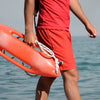Understanding the Lifeguard Spine Board: Essential Equipment for Water Safety

When it comes to water safety and rescue operations, lifeguards play a crucial role in ensuring the well-being of swimmers and beachgoers. One of the key pieces of equipment in their arsenal is the lifeguard spine board, a vital tool used in emergency situations. Let's delve into what a lifeguard spine board is, its functions, and its significance in water safety.
What is a Lifeguard Spine Board?
A lifeguard spine board, also known as a backboard, is a rigid, flat board usually made of plastic or composite material. It's designed to safely immobilize and transport individuals with potential spinal injuries, particularly those occurring in water-related accidents or emergencies.
Key Features of a Lifeguard Spine Board:
1. Rigidity and Sturdiness: The board is intentionally rigid to prevent any flexing or bending, ensuring the stability of the injured person's spine during transport.
2. Strap System: Equipped with securing straps or belts, the spine board allows lifeguards to immobilize the individual by strapping them securely to the board to prevent movement that could exacerbate spinal injuries.
3. Lightweight and Buoyant: Many lifeguard spine boards are designed to be lightweight and buoyant, making them suitable for water-related emergencies, including pool incidents or beach rescues.
4. Radiolucent Material: Some modern spine boards are made from radiolucent materials, allowing medical professionals to conduct X-rays without removing the patient from the board, reducing movement and potential risk of further injury.
Importance in Water Safety:
1. Spinal Injury Immobilization:
In water-related accidents, there's a risk of spinal injuries due to diving, impacts, or sudden movements. A lifeguard spine board enables quick and safe immobilization of the spine, reducing the risk of exacerbating potential injuries during transport.
2. Safe Extrication from Water:
When a swimmer or individual is suspected of having a spinal injury, moving them from the water poses risks. A spine board helps safely extract the person from the water while keeping their spine stabilized.
3. Professional Medical Care:
Once the injured individual is stabilized on the spine board, lifeguards can swiftly transport them to medical professionals, ensuring timely and appropriate medical attention.
Conclusion:
The lifeguard spine board stands as an indispensable tool in water safety and rescue operations. It plays a critical role in immobilizing and transporting individuals with suspected spinal injuries, reducing the risk of further harm. By enabling lifeguards to provide swift and secure care, this equipment significantly contributes to ensuring the safety and well-being of those in aquatic environments.
The utilization of the lifeguard spine board underscores the commitment of lifeguards to preserving lives and underscores the importance of professional training and equipment in safeguarding water-related activities.
- Posted in Lifeguard Spineboard

